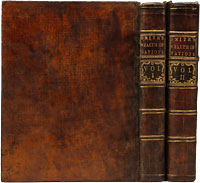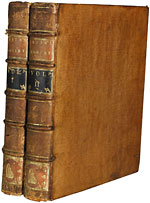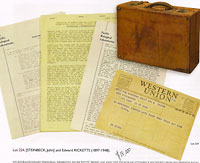Jean Grolier’s copy of Hypnerotomachia Poliphili and Einstein’s autographed draft of his General Theory of Relativity are among the notable buys this summer
You pays your money, you takes your choice
Adam Smith, An Inquiry into the Nature and Causes of the Wealth of Nations, £63,650 ($103,280) and £61,250 ($93,075) at Sotheby’s London on December 17 (2009) and July 14.
First published in London in the momentous year of 1776, this is a work that has been described as the first and greatest classic of modern economic thought. Donald Winch, who wrote the entry on Smith for the British Dictionary of National Biography, said of the book: “It had no rival in scope or depth when published and is still one of the few works in its field to have achieved classic status, meaning simply that it has sustained yet survived repeated reading, critical and adulatory, long after the circumstances which prompted it have become the object of historical enquiry.”
Both copies are in smart contemporary calf bindings with colored morocco labels to the gilt decorated spines. Shown here bearing the Pan amongst the reeds emblem of the Sledmere House (Yorkshire) library of Sir Christopher Sykes (1749-1801) at the foot of each volume, is the copy sold last December. The more recently seen copy bears the armorial bookplate of Thomas Papillon, perhaps a member of old Huguenot family who had residences at Acrise Place in my home county of Kent and at Crowhurst Park in neighboring Sussex.
“His mind had no horizon and his sympathy had no warp”
A John Steinbeck/Ed Ricketts archive, $21,960 at Bloomsbury New York on June 23.
“Ed seriously injured late today when train hit car—Ritch.” When a shocked John Steinbeck received this telegram in May 1948, he left immediately for Monterey, but by the time he got there his good friend Ed Ricketts, the man he later described as being “part of my brain for 18 years,” was dead.
The two had met in 1930 and Ricketts, a marine biologist and ecologist as well as the writer’s close friend, had been his collaborator on The Sea of Cortez (1941), a journal of their travels and marine research in the Gulf of California. Ricketts’ more familiar literary memorial, however, is as the model for Doc, the sympathetic, wise and lonely owner of the Western Biological Laboratory in Monterey in Steinbeck’s Cannery Row.
In the book, Steinbeck describes the character he based on his friend as a man “who would listen to any kind of nonsense and change it for you into a kind of wisdom. His mind had no horizon and his sympathy had no warp.”
That fateful Western Union telegram, along with an assortment of correspondence and longer typed accounts by Ricketts of trips made along the Pacific shores in 1945 and ’46, all contained in Ricketts’ own leather briefcase, was part of part of a much larger Steinbeck archive that came originally from the New York apartment in which he and his third wife, Elaine, had lived together for thirteen years. Steinbeck died in 1968, but Elaine survived him by 35 years, and, as often happens when the dispersal of an estate involves a multi-layered family, there was some delay in reaching an equable settlement. The books, manuscripts, letters, photographs, and personal effects that eventually came to auction had been tied up for the past six or seven years.
The Ricketts lot was very successful, but the dispersal was overall somewhat disappointing. An attempt to sell the archive as single lot (estimate $200,000-250,000) failed, and when the lots were then offered separately, around half failed to sell and few managed even low estimate sums—although a job lot of pipes, spectacles, lighters, keys, etc., sold well at $2,928, and a group of 16mm films and audio tapes, the latter including a recording of Steinbeck reading his 1957 story, “The Crap Shooter,” reached $4,148.








 Ian McKay’s weekly column in Antiques Trade Gazette has been running for more than 30 years.
Ian McKay’s weekly column in Antiques Trade Gazette has been running for more than 30 years.

